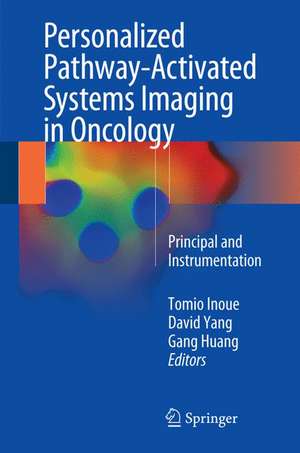Personalized Pathway-Activated Systems Imaging in Oncology: Principal and Instrumentation
Editat de Tomio Inoue, David Yang, Gang Huangen Limba Engleză Hardback – 10 mar 2017
Radiopharmaceuticals are used for diagnosis of diseases of the central nervous and cardiovascular systems and for staging, restaging, and treatment planning for cancers. Nuclear biomarkers allow precise measurement of molecular pathways on a whole-body image upon administration of functional radiolabeled agents, and nuclear imaging agentshave potential use in patient selection, pharmacokinetic, dosage-finding, and proof-of-concept studies. Nuclear imaging agents and hybrid instrumentation also provide sensitive and specific answers for differential responsiveness in therapeutic outcome.
This book serves as a reference for moving the discovery and development of radiopharmaceuticals from the workbench to clinical applications. It thus benefits not only clinicians but also translational research scientists—molecular biologists, chemists, imaging scientists, pharmaceutical developers, physicists, and support staff.
| Toate formatele și edițiile | Preț | Express |
|---|---|---|
| Paperback (1) | 705.74 lei 38-44 zile | |
| Springer Nature Singapore – 8 aug 2018 | 705.74 lei 38-44 zile | |
| Hardback (1) | 1110.90 lei 3-5 săpt. | |
| Springer Nature Singapore – 10 mar 2017 | 1110.90 lei 3-5 săpt. |
Preț: 1110.90 lei
Preț vechi: 1169.36 lei
-5% Nou
Puncte Express: 1666
Preț estimativ în valută:
212.57€ • 222.40$ • 176.58£
212.57€ • 222.40$ • 176.58£
Carte disponibilă
Livrare economică 12-26 martie
Preluare comenzi: 021 569.72.76
Specificații
ISBN-13: 9789811033483
ISBN-10: 981103348X
Pagini: 243
Ilustrații: XII, 243 p. 112 illus., 71 illus. in color.
Dimensiuni: 155 x 235 mm
Greutate: 0.83 kg
Ediția:1st ed. 2017
Editura: Springer Nature Singapore
Colecția Springer
Locul publicării:Singapore, Singapore
ISBN-10: 981103348X
Pagini: 243
Ilustrații: XII, 243 p. 112 illus., 71 illus. in color.
Dimensiuni: 155 x 235 mm
Greutate: 0.83 kg
Ediția:1st ed. 2017
Editura: Springer Nature Singapore
Colecția Springer
Locul publicării:Singapore, Singapore
Cuprins
Part 1: Chemical Biology Aspect.- Chapter 1: PET Radiotracers for Tumor Imaging (Ming Rong Zhang).- Chapter 2. Theranostic tracers for pathway-activated systems in oncology (Lan V. Pham, Jerry L. Bryant, David Yang, and Richard J. Ford).- Chapter 3. Optimization of Aseptic Production in PET Radiopharmaceuticals for Compliance to the Most Current GMP (Chih-Hao K. Kao) - Part 2: Engineering and Instrumentation Aspect.- Chapter 4. OpenPET enabling PET imaging during radiotherapy (Taiga Yamaya and Hideaki Tashima).- Chapter 5. High Resolution PET/CT development (Wai-Hoi Wong, and Yuxuan Zhang).- Part 3: Social Aspect.- Chapter 6. Ethics, Regulations and Clinical Development of Precision Medicine: Activating with molecular imaging (Chieko Kurihara, and Tomio Inoue).- Chapter 7. Optical Imaging: How far can we go (Wenbin Ma, Sara Herrera-Rodriguez, and Hector Martinez-Valdez).- Part 4: Clinic Aspect.- Chapter 8. Applications of UIH High Resolution PET/CT in Zhongshan Hospital (Jun Zhou, Hongcheng Shi).- Chapter 9. Clinical evaluation of focused high-resolution breast PET (Kanae Kawai Miyake, Yuji Nakamoto).- Chapter 10. Recent Developments with Large-bore PET/CT (Tomohiro Kaneta, Tomio Inoue).- Chapter 11. Copper-labeled radiopharmaceuticals in oncology (Hiroaki Kurihara).- Chapter 12. PET radiopharmaceuticals in oncology beyond FDG (Shao-Li Song, Pan-Li Li, Gang Huang).- Chapter 13. Molecular Imaging in Oncology: Challenges and Opportunities in 21st Century (Ya-Ming Li, Ya-Ming Li, David J. Yang, and Xue-Na Li).- Chapter 14. Visualization of Apoptosis: Annexin V imaging (Skye Hsin-Hsien Yeh, Fan-Lin Kong, Ming-Hsien Lin).
Notă biografică
Dr. Tomio Inoue
President, Yokohama City University Medical Center
Dr. David J. Yang
Professor and Section Chief, Radiotheranostic Section,
Department of Cancer System Imaging,
Division of Diagnostic Imaging,
MD Anderson Cancer Center,
Consultant and Professor at The University of Tennessee Health Science Center,
Vice-president for Vyripharm Biopharmaceuticals
Dr. Gang Huang
Chairman, Institute of Nuclear Medicine,
Shanghai JiaoTong University School of Medicine
President, Yokohama City University Medical Center
Dr. David J. Yang
Professor and Section Chief, Radiotheranostic Section,
Department of Cancer System Imaging,
Division of Diagnostic Imaging,
MD Anderson Cancer Center,
Consultant and Professor at The University of Tennessee Health Science Center,
Vice-president for Vyripharm Biopharmaceuticals
Dr. Gang Huang
Chairman, Institute of Nuclear Medicine,
Shanghai JiaoTong University School of Medicine
Textul de pe ultima copertă
This comprehensive volume covers radiopharmaceuticals developed for pathway-directed systems in imaging and theranostic applications. We now are at the cutting edge of providing personalized treatment with increased use in oncology of these new radiopharmaceuticals. Trends in high-resolution instrumentation development, quality assurance systems and regulatory compliance for radiopharmaceuticals, clinical evaluation of radiopharmaceuticals, and benefits and pitfalls of the current clinical FDG PET are discussed.
Radiopharmaceuticals are used for diagnosis of diseases of the central nervous and cardiovascular systems and for staging, restaging, and treatment planning for cancers. Nuclear biomarkers allow precise measurement of molecular pathways on a whole-body image upon administration of functional radiolabeled agents, and nuclear imaging agents have potential use in patient selection, pharmacokinetic, dosage-finding, and proof-of-concept studies. Nuclear imaging agents andhybrid instrumentation also provide sensitive and specific answers for differential responsiveness in therapeutic outcome.
This book serves as a reference for moving the discovery and development of radiopharmaceuticals from the workbench to clinical applications. It thus benefits not only clinicians but also translational research scientists—molecular biologists, chemists, imaging scientists, pharmaceutical developers, physicists, and support staff.
Radiopharmaceuticals are used for diagnosis of diseases of the central nervous and cardiovascular systems and for staging, restaging, and treatment planning for cancers. Nuclear biomarkers allow precise measurement of molecular pathways on a whole-body image upon administration of functional radiolabeled agents, and nuclear imaging agents have potential use in patient selection, pharmacokinetic, dosage-finding, and proof-of-concept studies. Nuclear imaging agents andhybrid instrumentation also provide sensitive and specific answers for differential responsiveness in therapeutic outcome.
This book serves as a reference for moving the discovery and development of radiopharmaceuticals from the workbench to clinical applications. It thus benefits not only clinicians but also translational research scientists—molecular biologists, chemists, imaging scientists, pharmaceutical developers, physicists, and support staff.
Caracteristici
Elucidates the benefits and pitfalls of current clinic FDG PET Enriches understanding of moving radiopharmaceuticals from the workbench to the clinic Provides translational research for clinical discussions about pathway directed systems imaging which correlates with genomic and proteomic expressions
